|
|
|
Sort Order |
|
|
|
Items / Page
|
|
|
|
|
|
|
| Srl | Item |
| 1 |
ID:
148472
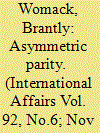

|
|
|
|
|
| Summary/Abstract |
The period 2008 to 2015 is likely to prove a traumatic transition from the post-Cold War era of American unipolar hegemony to a new status quo of asymmetric parity between the US and China. With approximately equal masses of production and one third of the world's total, the relationship of the United States and China will remain the focus of global politics for the foreseeable future. While parity in economic mass makes each the greatest concern of the other, their asymmetry in wealth, developmental levels, and geopolitical concerns makes unnecessary a power transition scenario. Hitherto the analysis of parity has assumed symmetry, and therefore the point of power transition and challenge is highlighted and strategy has focused on relative gain vis-à-vis the rival. With asymmetric parity the transitional moment becomes ambiguous, and it is a reasonable strategy for each side to pursue absolute gain. Sustainable asymmetric rivalry is competitive, but it can also be win-win. Moreover, neither the US nor China—nor the two together—can exercise the kind of hegemonic control that was the premise of earlier bipolar and unipolar eras. The diffuse interdependence created by globalization gives every state broader alternatives and raises the cost of hostility. The US and China do not face each other as hegemon and challenger, but rather as the largest, but quite different, players in a multinodal world that neither controls.
|
|
|
|
|
|
|
|
|
|
|
|
|
|
|
|
| 2 |
ID:
160371
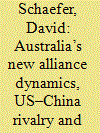

|
|
|
|
|
| Summary/Abstract |
Canberra’s exposure to great-power conflict is arguably more complex and ambiguous than during the Cold War. Drawing from scholarly literature on entrapment and recent developments in outer-space security, this article explores Australia’s position in a hypothetical US–China war over Taiwan. The shifting military balance in outer space, recent war games by the US military and regional trends in defence planning all raise the possibility of a scenario opening with Chinese cyberattacks against information networks shared between Australia and the USA. As a result of its growing dependency on space systems, Australia may be entrapped in a novel way which poses questions for scholars and policymakers. These findings should encourage further study of regional crisis management, with the need for a shared understanding of strategic behaviour in outer space and cybernetworks.
|
|
|
|
|
|
|
|
|
|
|
|
|
|
|
|
| 3 |
ID:
141197
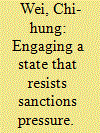

|
|
|
|
|
| Summary/Abstract |
Why did President Bill Clinton, while having linked human rights to China’s most-favoured-nation (MFN) status in 1993, delink the two issues in 1994, despite the fact that China had not improved its human rights record? This article explains Clinton’s linkage-delinkage policy reversal in terms of ‘strategic co-constitution’. After Tiananmen, Washington was concerned about China’s human rights abuses, arms proliferation and unfair trade practices. During 1992−3, Clinton initiated a ‘strategic social construction’ process that translated human rights into the linkage policy. Clinton stressed that a humane, democratic China would neither proliferate weapons nor engage in unfair trade practices. In 1994, however, a pro-MFN coalition persuaded Clinton that open trade could better advance US security, economic and human rights interests in China. Framing their rhetoric in ways that resonated with the exiting US concerns over China, pro-MFN actors led a strategic social construction process that redefined Clinton’s China policy toward engagement.
|
|
|
|
|
|
|
|
|
|
|
|
|
|
|
|
| 4 |
ID:
145749
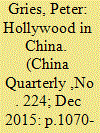

|
|
|
|
|
| Summary/Abstract |
While most mainland Chinese today have extremely few direct contacts with either America or Americans, their indirect contacts with both, via globalized American popular culture, are increasing rapidly. Do daily parasocial contacts with American celebrities shape Chinese views of America? Based on two experimental studies, this paper argues that even indirect, subconscious exposure to American celebrities via popular magazine covers shapes Chinese views of America. However, the impact of that exposure depends upon both the specific nature of the bicultural exposure and the psychological predispositions of the Chinese involved. Not all Chinese are alike, and their personality differences shape whether they experience American popular culture as enriching or threatening, leading to integrative and exclusionary reactions, respectively.
|
|
|
|
|
|
|
|
|
|
|
|
|
|
|
|
| 5 |
ID:
165151
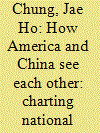

|
|
|
|
|
| Summary/Abstract |
Based on the premise that perception operates either as a catalyst or a constraint for a hegemonic war, this study examines ‘national perceptions’ (i.e. how the citizens of the two states view each other) and ‘official views’ (i.e. how the two governments perceive each other) between the US and China of the post-Cold War period. As for the national views, (1) American perceptions of China have generally become more negative than Chinese perceptions of America; (2) little congruence is found between the two powers on key values and norms; and (3) perceptions are generally getting far ahead of the realities. As for the official views, formal documents do not fully reveal their real state of minds. Diplomatic courtesy and strategic self-esteem runs through them. Yet, America’s strategic concern and growing will to manage China from a position of strength is increasingly more discernible. From the Chinese documents, on the other hand, signs of inferiority have gradually disappeared. In sum, perceptions between the two are working more as a catalyst for strategic competition than a constraint on it.
|
|
|
|
|
|
|
|
|
|
|
|
|
|
|
|
| 6 |
ID:
170628
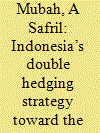

|
|
|
|
|
| Summary/Abstract |
This study highlights Indonesia’s strategy in response to the growing competition between the United States and China. In recent years, Indonesia under the administration of President Joko Widodo has played a strategic role in maintaining regional stability in the Indo-Pacific amid inflaming tensions between the two countries. On the basis of an “independent and active” foreign policy with Association of Southeast Asian Nations (ASEAN) at the center of a concentric circle, Indonesia has employed a hedging strategy to bolster regional stability and foster cooperation among countries in the region. While there may be room for a hedging strategy, it is important to understand how Indonesia has employed this strategy to shape the regional order. This paper argues that Indonesia has adopted a double hedging strategy of economic pragmatism on the one hand and limited bandwagoning on the other. The former includes a deepening of economic cooperation with China through collaboration between Indonesia’s vision of a Global Maritime Fulcrum and China’s Belt and Road Initiative. The latter includes keeping the US involved in the Indo-Pacific by proposing its Indo-Pacific concept to regional players without challenging the existing proposals offered by major powers. This paper consists of four sections. The first section introduces the theoretical basis by focusing on Indonesia’s foreign policy ideas as it deals with competition between great powers. The second section discusses the synthesis of Indonesia’s vision of a Global Maritime Fulcrum and concept of the Indo-Pacific. The third section demonstrates how Indonesia has employed its double hedging strategy. The fourth section highlights the conclusions of this study by summarizing Indonesia’s response to competition between the US and China and providing recommendations for further research.
|
|
|
|
|
|
|
|
|
|
|
|
|
|
|
|
| 7 |
ID:
158257
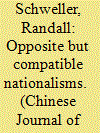

|
|
|
|
|
| Summary/Abstract |
China’s new assertiveness and the sudden inward turn of United States are a function of causes located in both the second and third images. The key second-image variable is nationalism, which combines with the power trajectories (a third-image variable) of both China and the United States to define how their relationship will unfold in the coming years. The interaction between nationalism and power trajectory produces entirely different foreign policy orientations in rising and declining powers—the former embraces an outward-looking, extroverted foreign policy of expansion, while the latter adopts an inward-looking, introverted foreign policy of restraint and retrenchment. The resurgent nationalisms of the rising challenger and the declining hegemon are entirely compatible with a future relationship characterized by peace and harmony. Obviously, the two nationalisms pose no inherent conflict of interests: China currently wants more global influence; the Unites States wants less. Hence, there is good reason to expect a soft landing as the world moves from unipolarity to bipolarity.
|
|
|
|
|
|
|
|
|
|
|
|
|
|
|
|
| 8 |
ID:
188664
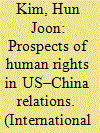

|
|
|
|
|
| Summary/Abstract |
What are the prospects of U.S.-China relations in the area of human rights? Skeptics maintain that human rights is no longer an issue between the United States and China. A traditional understanding of U.S.–China relations ignores the role of norms, while the constructivist perspective recognizes their independent effects. This paper links the traditional understanding of power politics between the United States and China with the study of constructivist norm research. The three findings of constructivist norm theories are relevant and applied to predict the status of human rights in U.S.-China relations: the historical construction of norms, the long-term and multifaceted effects of norms, and the persistence of norms. Based on these theoretical predictions, it is expected that, although convergence is not completely impossible, the past dynamic of competition and confrontation will continue and human rights will still be a contentious issue in U.S.-China relations.
|
|
|
|
|
|
|
|
|
|
|
|
|
|
|
|
| 9 |
ID:
159469
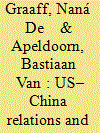

|
|
|
|
|
| Summary/Abstract |
The future of liberal internationalism will be influenced increasingly by the re-emergence of China as a major power on the world stage and by the way the United States is reacting to China's growing influence. In this article, we discern three possible scenarios: one of inevitable conflict, one of gradual co-optation and a hybrid scenario of coexistence. We argue that in order to understand the development of the Sino-US relationship and the sometimes-contradictory outcomes and dilemmas this generates, we need to take into account the social and domestic sources of foreign policy within these two major powers, and the distinctive state–society models that they represent. Crucially, this includes how the domestic political economy is dynamically interrelated with the global political economic context. In our approach, foreign policy elites form a key nexus here and a vital prism through which to analyse foreign policy strategies. From this critical political economy perspective, we will describe how China's re-emergence as a world power is partly shaped by its distinctive ‘statist’ state–society model, to then analyse US strategy towards rising China through the lens of the close nexus between America's corporate elite and the state. In our concluding section we will return to the three scenarios. Based on the findings presented, and in light of the radical shift that seems to be occurring due to the Trump presidency, we will reflect on the likelihood of these scenarios, the future of the liberal world order and conclude with a research agenda.
|
|
|
|
|
|
|
|
|
|
|
|
|
|
|
|
| 10 |
ID:
180382
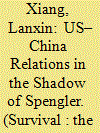

|
|
|
|
|
| Summary/Abstract |
For the US to try to defuse its domestic crisis by redirecting racist sentiments against China would be a grave political and strategic mistake.
|
|
|
|
|
|
|
|
|
|
|
|
|
|
|
|
| 11 |
ID:
152090
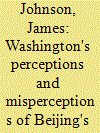

|
|
|
|
|
| Summary/Abstract |
Washington has become increasingly concerned that Beijing's anti-access area-denial (A2-AD) capabilities will put at risk US military assets and forward forces operating in the Western Pacific region, enabling China to deter, delay and deny US intervention in future regional conflict and crisis. US defence analysts in their assessments have frequently, and often erroneously, conflated a Chinese operational capability with an underlying strategic intention that conceptualises the United States as its primary (if not sole) target. The central argument this article proffers is that US perceptions of A2-AD have been framed by specific analytical baselines that have overlooked the evolution of Chinese operational and doctrinal preferences, and over-reliant upon military material-based assessments to determine Beijing's strategic intentions, and formulate US military countervails. The article concludes that the strategic ambiguities and opacity associated with Chinese A2-AD capabilities and its ‘active defence’ concept reinforced Washington's reliance upon capacity-based assessments that in turn, exacerbated misperceptions confounded by cognitive bias of Chinese strategic intentions. The critical framing assumptions of this article draw heavily upon the ideas and rationale associated with the international relations ‘Security Dilemma’ concept.
|
|
|
|
|
|
|
|
|
|
|
|
|
|
|
|
|
|
|
|
|